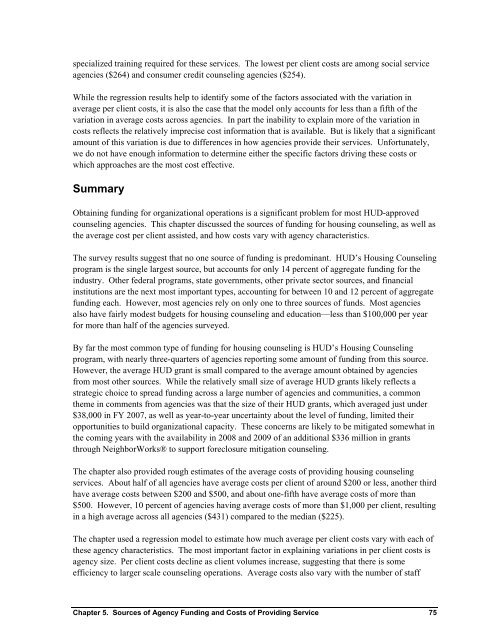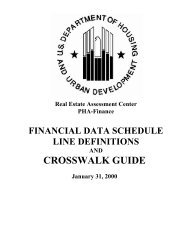Housing Counseling Process Evaluation and Design of ... - HUD User
Housing Counseling Process Evaluation and Design of ... - HUD User
Housing Counseling Process Evaluation and Design of ... - HUD User
Create successful ePaper yourself
Turn your PDF publications into a flip-book with our unique Google optimized e-Paper software.
specialized training required for these services. The lowest per client costs are among social service<br />
agencies ($264) <strong>and</strong> consumer credit counseling agencies ($254).<br />
While the regression results help to identify some <strong>of</strong> the factors associated with the variation in<br />
average per client costs, it is also the case that the model only accounts for less than a fifth <strong>of</strong> the<br />
variation in average costs across agencies. In part the inability to explain more <strong>of</strong> the variation in<br />
costs reflects the relatively imprecise cost information that is available. But is likely that a significant<br />
amount <strong>of</strong> this variation is due to differences in how agencies provide their services. Unfortunately,<br />
we do not have enough information to determine either the specific factors driving these costs or<br />
which approaches are the most cost effective.<br />
Summary<br />
Obtaining funding for organizational operations is a significant problem for most <strong>HUD</strong>-approved<br />
counseling agencies. This chapter discussed the sources <strong>of</strong> funding for housing counseling, as well as<br />
the average cost per client assisted, <strong>and</strong> how costs vary with agency characteristics.<br />
The survey results suggest that no one source <strong>of</strong> funding is predominant. <strong>HUD</strong>’s <strong>Housing</strong> <strong>Counseling</strong><br />
program is the single largest source, but accounts for only 14 percent <strong>of</strong> aggregate funding for the<br />
industry. Other federal programs, state governments, other private sector sources, <strong>and</strong> financial<br />
institutions are the next most important types, accounting for between 10 <strong>and</strong> 12 percent <strong>of</strong> aggregate<br />
funding each. However, most agencies rely on only one to three sources <strong>of</strong> funds. Most agencies<br />
also have fairly modest budgets for housing counseling <strong>and</strong> education—less than $100,000 per year<br />
for more than half <strong>of</strong> the agencies surveyed.<br />
By far the most common type <strong>of</strong> funding for housing counseling is <strong>HUD</strong>’s <strong>Housing</strong> <strong>Counseling</strong><br />
program, with nearly three-quarters <strong>of</strong> agencies reporting some amount <strong>of</strong> funding from this source.<br />
However, the average <strong>HUD</strong> grant is small compared to the average amount obtained by agencies<br />
from most other sources. While the relatively small size <strong>of</strong> average <strong>HUD</strong> grants likely reflects a<br />
strategic choice to spread funding across a large number <strong>of</strong> agencies <strong>and</strong> communities, a common<br />
theme in comments from agencies was that the size <strong>of</strong> their <strong>HUD</strong> grants, which averaged just under<br />
$38,000 in FY 2007, as well as year-to-year uncertainty about the level <strong>of</strong> funding, limited their<br />
opportunities to build organizational capacity. These concerns are likely to be mitigated somewhat in<br />
the coming years with the availability in 2008 <strong>and</strong> 2009 <strong>of</strong> an additional $336 million in grants<br />
through NeighborWorks® to support foreclosure mitigation counseling.<br />
The chapter also provided rough estimates <strong>of</strong> the average costs <strong>of</strong> providing housing counseling<br />
services. About half <strong>of</strong> all agencies have average costs per client <strong>of</strong> around $200 or less, another third<br />
have average costs between $200 <strong>and</strong> $500, <strong>and</strong> about one-fifth have average costs <strong>of</strong> more than<br />
$500. However, 10 percent <strong>of</strong> agencies having average costs <strong>of</strong> more than $1,000 per client, resulting<br />
in a high average across all agencies ($431) compared to the median ($225).<br />
The chapter used a regression model to estimate how much average per client costs vary with each <strong>of</strong><br />
these agency characteristics. The most important factor in explaining variations in per client costs is<br />
agency size. Per client costs decline as client volumes increase, suggesting that there is some<br />
efficiency to larger scale counseling operations. Average costs also vary with the number <strong>of</strong> staff<br />
Chapter 5. Sources <strong>of</strong> Agency Funding <strong>and</strong> Costs <strong>of</strong> Providing Service 75
















